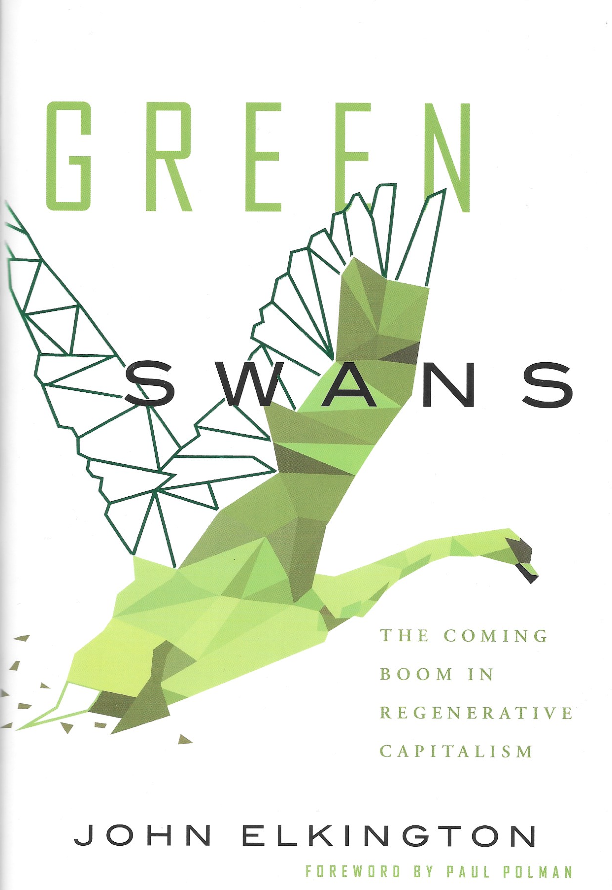The one sentence summary
Green swans can take us exponentially to breakthrough solutions through regenerative capitalism.
Can’t be bothered to read it? Listen to the summary in two parts.
WHAT THE BOOK SAYS

- A Green Swan is a profound market shift that delivers exponential progress in economic, social and wealth creation. Black Swans are problems that lead exponentially to degenerative breakdown (They are sometimes said to occur gradually, then suddenly.) Green Swans take us exponentially to regenerative breakthrough. We need to rein in the first and accelerate the second.
- An Ugly Duckling is an early-stage concept which could go either way.
- There are also Grey Swans, which may have been predicted, but then ignored for too long. They can erupt in ways that can rock the world.
- This is a manifesto for system change designed to serve people, the planet and prosperity. Capitalism in its current form is broken. Capitalism, democracy and sustainability are fiercely contested territory. They need to be transformed to adopt green swan characteristics and help regenerate our natural, social and economic worlds through regenerative capitalism.
- Impact investing intentionally seeks measurable social and environmental benefits. This is at the heart of regenerative capitalism. It is different from socially responsible investing which traditionally avoids those inconsistent with the values of the investors (tobacco, arms, etc.)
- We need to embrace uncertainty and discomfort, experiment with new economic and political models, identify opportunities for 10X solutions (improving things by 10% won’t do), and use the Sustainable Development Goals as a North Star to guide it all.
- Corporations need to establish a responsible purpose and business model, looking at their impact, governance and their stranded assets – those that could be rendered useless by black swan events. They need to move from shareholder to system value – in no way hindering societal quality, and ideally contributing to it. Energy should be renewable and available to all; water responsibly sourced and available to all; waste should not exist; natural resources safeguarded; the environment free from pollution; ecosystems protected; with people leading sustainable and fulfilling lives.
- Dealing with sustainability issues is essentially a wicked problem. Wicked problems typically have no definitive formulation; are hard or impossible to measure; bleed into one another; provide no template to follow; have many explanations; are often symptoms of another problem; usually involve a one-shot effort; and are unique every time.
- They become super wicked problems when time is running out, there is no central authority, those seeking to solve them are also causing them, and current policies discount the future irrationally. Examples are plastic in oceans, obesity, antibiotics breeding deadlier bugs, carbon, and space junk.
- Interestingly, humanity has all the techniques at hand to reverse global warming – nothing new needs to be invented.
WHAT’S GOOD ABOUT IT
- The author invented the triple bottom line concept in 1994 and withdrew the idea in 2018 – a conceptual product recall. He was worried that it had become a placebo button for companies. A placebo button creates the illusion of control but doesn’t actually do anything, such as those at some pedestrian crossings. In other words, businesses had adopted some of the principles of the triple bottom line, but it hadn’t changed things that much.
- He has since acknowledged that the people, planet, profits notion can remain useful, so long as it is viewed in the context of the three Rs; Responsibility, Resilience and Regeneration.
- There are 5 stages in getting from Rejection to Regeneration:
- Rejection (refusal to accept the possibility of either Black or Green Swans, often displayed through predatory delay – blocking change); Responsibility (broadly responsible leadership, but with the emphasis still on the status quo); Replication (partnering to change things for the better); Resilience (from disruption of the communities, cities and countries where they operate); Regeneration (fixing all sustainability problems for the betterment of everybody and the planet).
- When PUMA calculated their first Environmental Profit & Loss statement, they found that 85% of their environmental impact came from distant tier 4 suppliers over which they had no specific control. Accounting for those costs responsibly would reduce their profits by 70%.
- “During the last 50 years, we doubled the world’s population, grew our economic activity eight-fold, and started using two to three times more global resources than ever before. Put another way, our society changed more in the last 50 years than at any other time in history. More startlingly, we changed more in the last 50 years than in the entirety of human existence.” Jonathan Foley.
WHAT YOU HAVE TO WATCH
- Not much. The book contains many original and thoughtful concepts.
